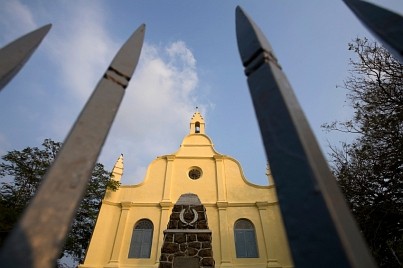 Cochin doesn’t receive the attention that it is arguably due, a fact that pleases the relatively few tourists who decide to take a look around. This town is full of historic sites dating to Portuguese colonial times, many of which were renovated or outright rebuilt by Dutch and British colonists.
Cochin doesn’t receive the attention that it is arguably due, a fact that pleases the relatively few tourists who decide to take a look around. This town is full of historic sites dating to Portuguese colonial times, many of which were renovated or outright rebuilt by Dutch and British colonists.Fort Kochi is at the center of the tourist bloc. Tourists can launch a walking tour from Vasco de Gama Square, taking in sights like the Chinese fishing nets and several of the city’s churches and forts. After seeing these sites, Mattancherry Palace - as knows as Dutch Palace - is the next logical stop.
More than a millennium old, this temple continues to be an important pilgrimage site. The temple is dedicated to a three-formed goddess, said to appear as Saraswathi (goddess of learning) in the morning; Lakshmi (goddess of prosperity and fertility) at noon; and Durga (the divine mother) in the evening.
Few would travel to India expecting to see an authentic Jewish synagogue but that’s just what Cochin has. It was built more than 450 years ago and at its height served a thriving population of worshippers. The small Jewish population that remains continues to worship here.
Visitors should head to Vasco da Gama Square to see the vintage fishing nets being used. Legend has it they were shipped in from the Kublai Khan’s kingdom. The nets employ an impressive system of pulleys and cantilevers, and fishermen still use them to pull in the day’s catch.
This is also called the ‘Dutch Palace’, although it was actually built by Portuguese colonizers in the 1500s. The Dutch came 100 years later and renovated the structure. Coronation robes and murals depicting scenes from Hindu scriptures are among the highlights.
Built by the Portuguese and later leveled by the British, this ruinous fort is a testament to the European power struggle that played out in this part of the world from the 16th to early 20th centuries. While most of the structure has disappeared, this is still an important landmark. There is also a great deal of tourist infrastructure here.
This is unique in that it’s the only protestant church in South India. Built early in the 16th century, it came to prominence as the temporary resting place for explorer, Vasco de Gama. His remains were later returned to Portugal.
Built by the Portuguese, this church became a cathedral in 1558 and was later promoted to basilica in 1984. In between, the original building was destroyed and rebuilt. The interior features exquisite stained glass windows.